Your support helps us to tell the story
From reproductive rights to climate change to Big Tech, The Independent is on the ground when the story is developing. Whether it's investigating the financials of Elon Musk's pro-Trump PAC or producing our latest documentary, 'The A Word', which shines a light on the American women fighting for reproductive rights, we know how important it is to parse out the facts from the messaging.
At such a critical moment in US history, we need reporters on the ground. Your donation allows us to keep sending journalists to speak to both sides of the story.
The Independent is trusted by Americans across the entire political spectrum. And unlike many other quality news outlets, we choose not to lock Americans out of our reporting and analysis with paywalls. We believe quality journalism should be available to everyone, paid for by those who can afford it.
Your support makes all the difference.Daebak! – pronounced DEH-bahk, often with a long, guttural emphasis on the first syllable – can be a noun, an adjective or an interjection that expresses approval when something is truly great.
It’s the Korean word my mother blurted out when she recently tasted my doenjang jjigae, a soybean-paste stew that has taken me years to perfect.
Some might measure a Korean cook’s prowess by their kimchi, an intimate way to get to know someone’s sohn mat, or hand taste, the immeasurable quality of a cook’s personal touch. But I would argue that doenjang jjigae, the humblest and most basic of Korean stews, is a window into a cook’s soul. The precision with which the vegetables are cut, the ratio of broth to soybean paste, and the clarity and balance of flavours can reveal a lot about a cook’s palate, as well as their priorities. Are they showing off or aiming to nourish? Is the stew in your face, or soothing you throughout the meal like a weighted blanket?
When my mother said my doenjang jjigae was “daebak”, I finally felt that I had graduated from her masterclass in Korean cooking. As the son of South Korean immigrants, I’ve been attending it since I was old enough to walk, a little shadow following her around our suburban Atlanta kitchen, tasting her kimchi for sugar and salt; helping her pick and wash perilla leaves from the garden for a family dinner of ssam; or, later in life, sitting at the kitchen island watching her crush gim, that glorious roasted seaweed, over a homecoming plate of kimchi fried rice.
I am no longer my mother’s shadow, but the way I cook now, the way I move and breathe in my New York City kitchen, has echoes of her movements, her breaths. So much of cooking is using your senses and following your gut, and I never experience those instincts more acutely than when I am making Korean food.
As a child, I used to lament that I had to attend Korean language school every Saturday morning (which is probably why now, every day after work, I unwind by watching all those cartoons I missed). Much like learning the language, learning the cuisine of my parents’ home country is a constant process of self-discovery, with each recipe unlocking a new way of connecting not just to South Korea but to my own culinary identity.
Here’s the thing: I’ve been Korean my whole life, and I’ve been cooking since I was 13, but only recently have I begun to feel like a Korean cook.
It wasn’t just my mother’s approval that made me feel that I had graduated from our lessons, though it meant a lot. It was that I had, over time, folded doenjang jjigae into my everyday cooking, right next to the other dishes in my repertoire like green salad, roast chicken and yeasted bread. As much as our festive tables reflect our aspirations when we’re at our highest and happiest, I’ve always felt that it’s the quotidian things we make for ourselves when we’re especially tired (and need to get food on the table) that tell the true story of who we are as cooks.
So when my editor asked me to share my essential Korean recipes – dishes that are elemental to me and my experience as a person of South Korean descent – I was honoured. But I was also terrified.
Throughout my career as a food writer, I’ve often felt the impulse to deflect any claim of authority or authenticity when putting Korean recipes into the world: who was I, a Korean American, to represent a centuries-old cuisine that has so many layers and variations throughout history and the diaspora?
What I’ve learnt, ultimately, is that my experience as a Korean American is my authority. I may not have been raised in Seoul, save for a couple summers while visiting my grandmother, but the city that took care of me, Atlanta, has a rich and bustling Korean American population (after English and Spanish, Korean is the most commonly spoken language in Georgia homes).
Many of us are Korean because of what’s in our hearts, not how fluent we are in Hangul, what our parents and grandparents look like or where our families have decided to lay down roots
Many of us are Korean because of what’s in our hearts, not how fluent we are in Hangul, what our parents and grandparents look like or where our families have decided to lay down roots.
These recipes, then, are what define Korean cuisine for me personally, which is why your own favourites might be missing from this list. But rest assured that jjajangmyeon, those slippery black-bean-paste noodles; maeuntang, that blaze of a fish stew; bulgogi, sweet and salty marinated grilled beef; and ganjang gejang, raw soy-sauced crabs, all trailed close behind these 10.
Anyway, in life but especially in cooking, there are no true universal essentials: every house, every restaurant, every cook does things a little differently. You could have dinner at five Korean families’ homes, for instance, and the doenjang jjigae would taste different at each of them.
Still, there are certain ingredients that come up time and again (they also explain why Korean food tastes the way it does: savoury, balanced, full of heart).
In the recipes that follow, you’ll see a lot of seaweed – whether as gim (roasted, seasoned sheets that shatter when pressed over a bowl of gyeran bap) or dasima (dried kelp that flavours soups, stews and even pasta sauces with oceanic depth and savouriness) – because South Korea’s shores are rife with it.
Korean radishes – sweeter, plumper and crisper than other varieties – are more than just a vegetable. They imbue broths and jjigaes with immeasurable balance. Daikon works in a pinch, but it is not the same as a Korean radish.
More than just condiments, doenjang (soybean paste), gochujang (red-pepper paste) and ganjang (soy sauce) lay the groundwork of many Korean dishes, underpinning all manner of stews, glazes, sauces, noodles and mixed rice dishes.
Chewy rice cakes, or tteok (pronounced somewhere between “tuck” and “duck”), are an ingredient, such as in tteokbokki, as much as they are a snack, grilled over a flame or grilled in the oven until crispy – then, in my home, dipped in honey and soy sauce.
Nothing tastes more Korean to me than a drop of toasted sesame oil over a bed of freshly steamed white rice and fried eggs. Its unparalleled nuttiness reaches my soul in a way that few things can.
The same gochugaru, or red-pepper powder, that stains crimson a head of napa cabbage kimchi is also used in other banchan, various dressed salads called muchims and uplifting jorims, or braises. It lends heat, sure, but it can also infuse a dish with incredible sweetness and an almost fermented savouriness, especially when you first bloom it in fats like sesame oil and butter.
I want everyone to experience the smell of gochugaru stirred through a pat of melted butter. You could fry an egg in it, or just use it as your aromatherapy for the day. “Daebak,” my mother would call it.
If I could have only 10 Korean dishes for the rest of my life, these would be the ones. They stem mostly from South Korean food traditions, and especially from Seoul, because that’s where my parents are from. Some of these dishes are more than their ingredients, speaking not only to the history of a divided nation and a war, but also to a gorgeous history of empires. These meals are fit for kings and queens, represent the resilience of the Korean people and come from a long line of home cooks.
I’ve written the recipes in English, but know that their souls are in Korean. And if you need a place to start, I hear the doenjang jjigae is daebak.
Doenjang jjigae
A well-executed doenjang jjigae can be a quiet but powerful exercise in restraint. This simple recipe allows the umami-rich flavour of the doenjang (DWEN-jahng), a fermented soybean paste, and the natural sweetness of onion, courgette and radish to shine. The oil-packed anchovies here may not be as traditional as dried, but they are an effective substitute that I learned from my friend James Park. You can make this dish vegan by skipping the anchovies and swapping the slightly lily-gilding rib-eye steak for cubed medium-firm tofu.
Total time: 15 minutes
Serves: 2
Ingredients:
5 tbsp doenjang, plus more to taste (see tip below)
4 garlic cloves, crushed and coarsely chopped
1 small red onion, cut into medium dice
1 medium courgette, cut into medium dice
140g Korean radish, peeled, quartered, then thinly sliced crosswise
85g fresh shiitake mushrooms, stems removed and caps thinly sliced
1 (10cm) square dasima (dried kelp), cracked into small pieces
4 oil-packed anchovies, drained
1 tbsp soy sauce
Salt
1 thin, boneless rib-eye steak (about 170g), cut into 2½cm pieces
Steamed white rice, for serving
Method:
1. To a medium pot, add the doenjang, garlic, onion, courgette, radish, mushrooms, dasima, anchovies, soy sauce and 700ml cold tap water, and season lightly with salt. Bring to a boil over high heat, then reduce the heat to gently boil, stirring once or twice, until the vegetables start to soften and the broth tastes intensely savoury and as salty as the sea, about 10 minutes. Adjust seasoning with more doenjang or salt as desired; the stew should be assertively seasoned.
2. Stir in the steak and continue gently boiling the jjigae, stirring once or twice, until the meat is just cooked through, about 5 minutes. Serve with bowls of fresh white rice.
Tips: You can find doenjang, often labeled “soybean paste”, in Korean or Asian supermarkets and online. Packed with umami and irresistible salinity, doenjang is a soulful flavour booster made of fermented soybeans and brine. For unparalleled savouriness, drop it into pasta sauce, slick it over fish or whisk it into your favourite salad dressing.
Tongbaechu kimchi (whole napa cabbage kimchi)
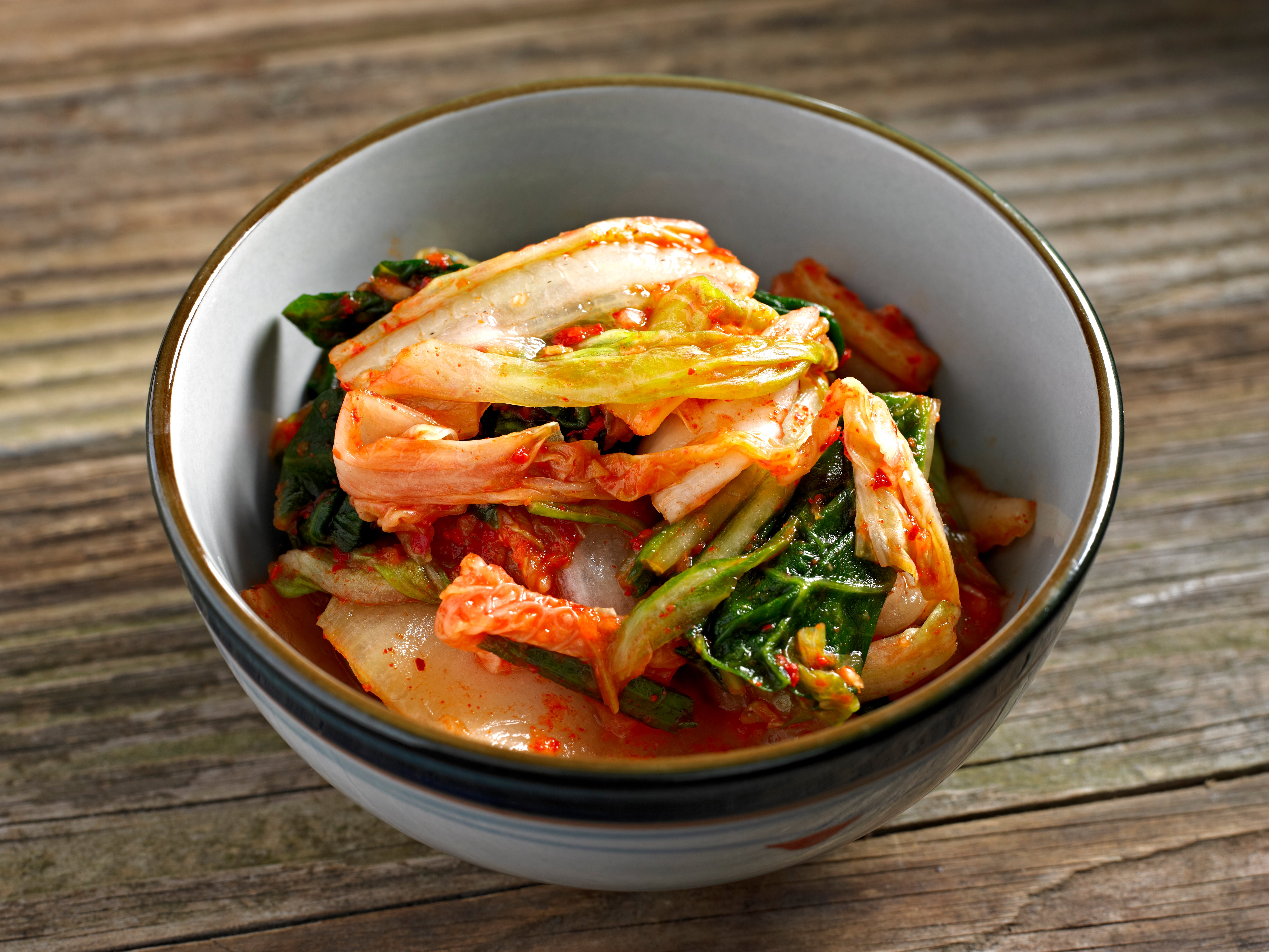
In Korean, the word kimchi describes a vast category of salted vegetables that are fermented until sour with lactic-acid bacteria. There are white varieties called baek kimchi and red ones stained with gochugaru. This tongbaechu kimchi, made with whole napa cabbage, is a wonderful way to witness firsthand the magic of preservation by salting. Though the first step – salting quartered cabbages to drain excess liquid – may require an afternoon, that time is entirely inactive. Walk away and live your life, then come back to sauce them, which takes only a few, short, relaxing movements. The bundles of sauced cabbage are jarred and left at room temperature for the first couple of days to jump-start the fermentation process, then refrigerated to continue souring slowly for weeks and even months. Fermenting bundled quarters – versus chopped pieces – results in a crisper, more flavourful cabbage kimchi.
Total time: 4¼ hours, plus at least 2 days’ fermenting
Serves: 1 (2L) jar (about 1.8kg kimchi)
Ingredients:
1 large napa cabbage (1-1.4kg), quartered lengthwise
45g coarse kosher salt or 85g coarse salt
2 medium red apples (such as Fuji, Gala or Honeycrisp)
1 small yellow onion, peeled and chopped
10 garlic cloves, peeled
1 (5cm) piece fresh ginger, peeled
120ml fish sauce
120ml gochugaru
1 tbsp granulated sugar
1 bunch spring onions, chopped into 1½cm pieces
Method:
1. Dry-brine the cabbage: rinse the cabbage quarters under cold running water and place on a large rimmed baking tray. Generously salt the cabbage all over, making sure to season between the leaves as well as the outsides (don’t worry about being too precise; since the cabbages leak water, the salt will distribute evenly into the brine). Set aside to brine at room temperature, cut sides up, until the hard leaves become limp and soggy, about 4 hours, flipping once or twice halfway through. During this brining time, the cabbage quarters should release plenty of water into the baking tray.
2. Make the sauce: quarter one of the apples, leaving it unpeeled. Core it, coarsely chop it, then add it to a food processor. Add the onion, garlic and ginger, and process until finely chopped. Add the mixture to a large bowl and stir in the fish sauce, gochugaru and sugar. Peel the remaining apple, quarter it, core it, then thinly slice it crosswise. Fold the chopped spring onions and thinly sliced apple into the sauce.
3. Rinse the salted cabbage quarters under cold running water, squeezing them of their excess liquid. Place one cabbage quarter into the bowl with the sauce. With clean hands, smear ¼ of the sauce all over the outsides and between each leaf, tucking in the larger pieces of spring onions and apple as well. Fold the cabbage quarter in half crosswise, gathering the leafy tail ends together and bringing them up and over the root end, to create a compact bundle. Place the bundle in the jar and repeat with the remaining three cabbage quarters until you have used up most of the sauce and the jar is filled with sauced cabbage, leaving about an inch of room on top (a few air gaps are fine; they’ll fill with liquid over time). Top the jar with any remaining sauce left behind in the bowl. Loosely close with a lid (see tip below). You can wash your hands at this stage.
4. Let the jar of kimchi begin fermenting on the kitchen counter at room temperature for 2 to 3 days. After this, the cabbage should have released even more of its liquid; it’s OK if the liquid doesn’t completely cover the cabbage at this point, though it may (this is a very juicy recipe). Refrigerate the kimchi to finish fermenting until it’s sour, 2 to 3 weeks and up to 6 months, at which point it will be very, very sour and should be eaten or turned into jjigae. Check (and taste!) the kimchi every 2 to 3 days both to familiarise yourself with the fermentation process but also to allow gas to escape, which you can do by opening the lid every so often. As you go through the jar over time, take out one cabbage quarter at a time and chop it into bite-size pieces to serve. You can eat the core or toss it.
Tips: One of the best containers for kimchi is a glass jar with a plastic lid. Stainless steel containers with metal lids (the kind that lock into place) are also traditionally used. Both types can be found online or at Korean supermarkets and work well for kimchi since the lids aren’t airtight. Avoid using Mason jars with airtight lids since they can explode as gas builds up during the fermentation process.
Samgyeopsal
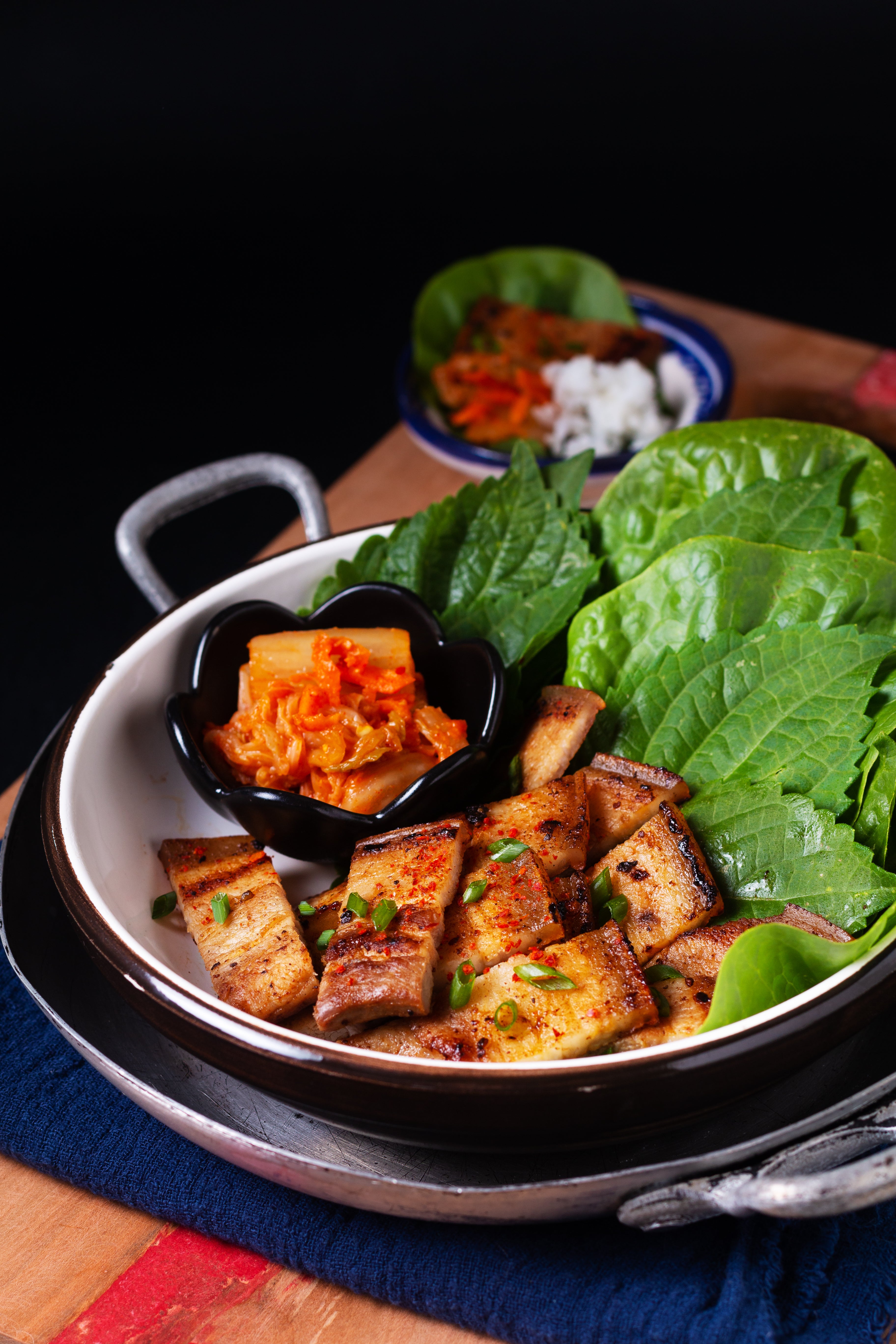
Samgyeopsal, or “three-layer meat”, refers to pork belly’s fat cap and the two leaner layers of meat below it, one light and one dark. A chill way to have Korean barbecue at home, this dish is less a recipe and more a road map to dinner. Crisp slivers of pork are wrapped in various lettuces and dabbed with doenjang honey and punchy slivers of raw garlic. The lightly peppered, vinegared freshness of pa muchim, an all-occasion spring onion salad often served with the grilled meats at Korean barbecue restaurants, is a welcome accompaniment to rich foods like fried or rotisserie-style chickens, pan-seared pork chops, and grilled bulgogi, galbi and samgyeopsal. Don’t skip the sesame oil dipping sauce; its nuttiness lets the pork belly shine.
Total time: 30 minutes
Serves: 4
Ingredients:
For the pa muchim:
4 spring onions, trimmed, cut into 7½cm segments, then very thinly sliced lengthwise into matchsticks
1 tbsp rice vinegar
2 tsp gochugaru
1 tsp toasted sesame oil
Pinch of granulated sugar
Coarse salt and freshly ground black pepper
For the samgyeopsal:
450g assorted lettuces, such as little gem, endive and perilla, leaves separated
4 garlic cloves
2 tbsp doenjang
1 tbsp honey
Coarse salt and freshly ground black pepper
4 tbsp toasted sesame oil
900g thinly sliced pork belly, cut into 5cm strips (see tip below)
Steamed white rice, for serving
Method:
1. Make the pa muchim: in a medium bowl, toss to combine the spring onions, vinegar, gochugaru, sesame oil and sugar. Season to taste with salt and pepper; set aside.
2. Prepare the samgyeopsal spread: wash and dry the lettuces and arrange on a large platter. Thinly slice the garlic cloves and place on a small plate, scooching the slices to one side. Make the doenjang honey by dabbing the doenjang onto the other side of the plate and drizzling the honey over the doenjang. Make the dipping sauce by adding 1 tsp salt and a generous grind of black pepper to 4 small dishes (or however many are dining); drizzle each dish with 1 tbsp sesame oil.
3. Cook the pork belly: heat a large frying pan over medium-high. Add half of the pork belly and cook, stirring occasionally, until the edges are crispy and lightly browned but the centers are still plump and meaty, 5 to 7 minutes. Transfer to a towel-lined platter. Drain the fat from the pan and discard. Repeat with the remaining pork belly. Serve immediately with bowls of fresh white rice.
4. To eat, dip the fried pork belly into the dipping sauce, then place on a lettuce leaf. Smear some of the doenjang honey onto the pork belly, top with a slice of raw garlic and a small chopstickful of pa muchim. Fold the lettuce wrap into a bundle and eat. Chase with the white rice. Another lovely thing to do: dip the lettuces into the doenjang honey or dipping sauce, and eat them like crudités between bites of crispy pork belly.
Tips: You can buy thinly sliced pork belly at Korean supermarkets, sometimes as long strips and often as individual rolled pieces made easy for grilling. You can also purchase pork belly as a long, thick slab, which can be sliced as thinly or thickly as you like. All that matters is that your pork is uncured and unseasoned, as it’s the pure flavour of the meat that makes samgyeopsal such a dream to eat.
Budae jjigae
Though it stems from the Korean War, budae jjigae – or “army base stew,” named after the leftover US army rations that make it up – is a symbol of resourcefulness and survival during a time of great poverty. The fiery broth is fortified with kimchi, gochujang and an assortment of flavourful sausages. Hot dogs are common, but kielbasa, breakfast sausage and Italian sausage all lend their own special character to the final broth, so use what you like. Arrange the ingredients in the pot in sections, and don’t stir too much while cooking: the joy of eating a big, burbling budae jjigae is reaching for your favourite part of the stew. For many, it’s the Spam, both salty and sweet; for others, it’s the American-cheese-laden noodles, bouncy with chew. Serve this soul-warming stew family style, with white rice to balance its punchy flavours.
Total time: 30 minutes
Serves: 4
Ingredients:
1 medium yellow onion, halved and thinly sliced
140g Korean radish or daikon, peeled, quartered, then thinly sliced crosswise
1 (340g) can Spam, quartered lengthwise and thickly sliced crosswise
450g link sausages (a mix of sliced kielbasa, hot dogs, breakfast sausages and sweet or spicy Italian sausages), cut into bite-size pieces
150g coarsely chopped napa cabbage kimchi
2 tbsp gochugaru
60ml gochujang
2 tbsp soy sauce
1 tbsp fish sauce
4 garlic cloves, crushed and coarsely chopped
Salt
1 (85-115g) package instant ramyun or ramen
1 slice American cheese
2 spring onions, thinly sliced on the diagonal
Steamed white rice, for serving
Method:
1. In a large, wide pot or casserole dish, arrange the onion, radish, Spam, sausages and kimchi in 5 individual piles. Over these piles, add the gochugaru, gochujang, soy sauce, fish sauce, garlic and 1.4L cold tap water (don’t worry about stirring at this stage).
2. Cover and bring to a rolling boil over high heat, then reduce the heat to a gentle boil. Partly cover the pot and stir the liquid gently and occasionally while leaving the piles intact, until the sausage is warmed through and the broth is deeply seasoned with meaty flavour, 15 to 20 minutes. Taste and add salt as needed; this stew has many salty ingredients, but a little salt brings out the nuances of each component, resulting in a wonderful broth.
3. Nestle in the noodles and cook according to package instructions, without stirring, until loose and chewy but not soggy and distended. Remove the pot from the heat. Top the noodles with the American cheese and cover until melted, just a few seconds. Scatter the spring onions over the stew and serve immediately in the center of the table, family-style, with a ladle, tongs and bowls of fresh white rice.
Miyeok guk (seaweed soup)
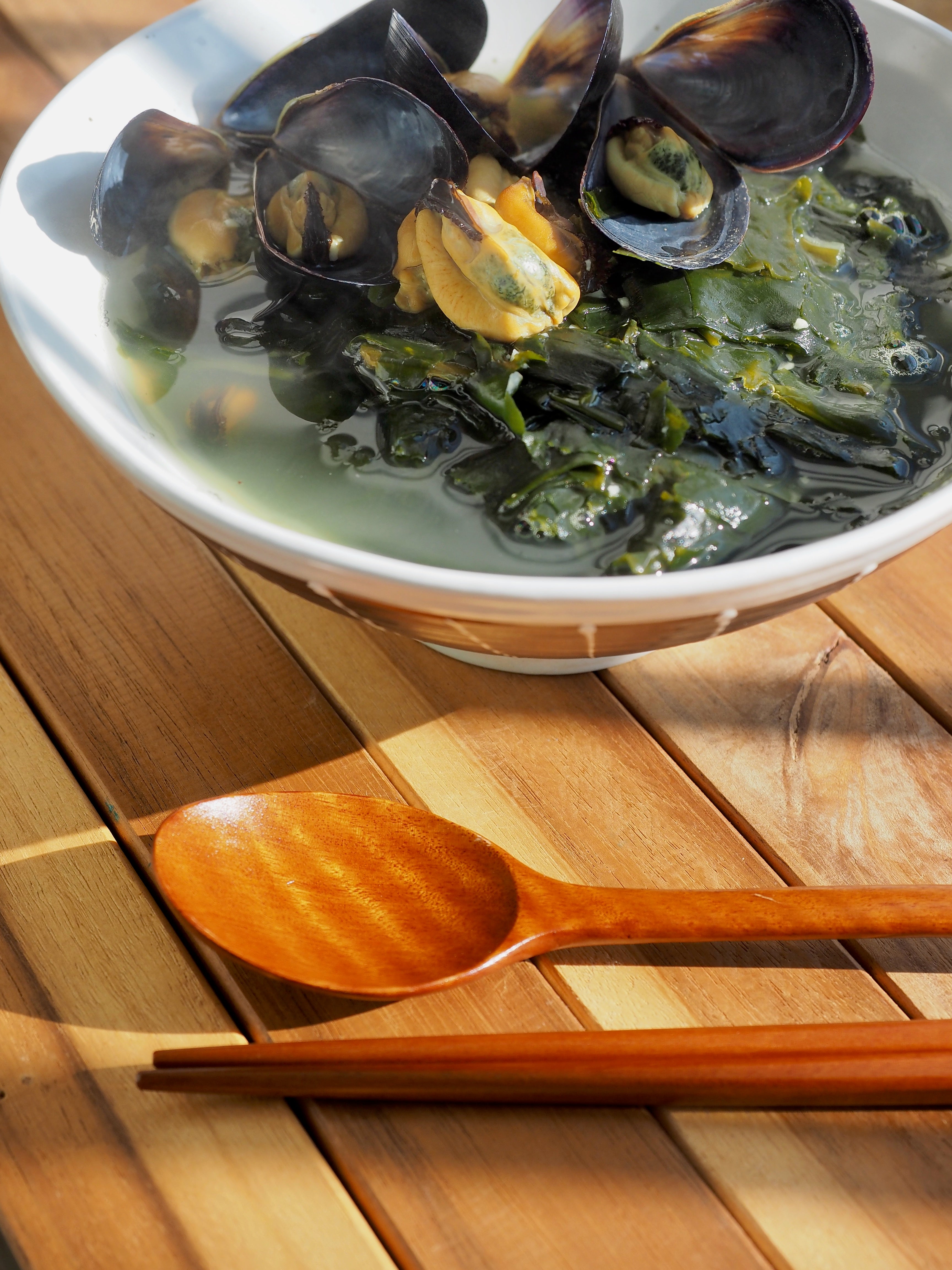
People eat miyeok guk on birthdays to celebrate not just their own birth, but their mother’s sacrifice as well – which is why it is often known as birthday soup. This miyeok guk (ME-yuhk gewk), or seaweed soup, forgoes the more common beef broth for mussels and an aromatic base of onion, garlic and anchovies. Though not traditional, the addition of parsnip, for sweetness and umami, yields a broth with body, like the kind you would get with the usual brisket. Scooped out of their shells, mussels become little morsels in the soup, nuggets of briny joy.
Total time: 50 minutes
Serves: 4 to 6
Ingredients:
450g fresh mussels
20g miyeok, often labelled as dried seaweed, crushed into small pieces
4 oil-packed anchovies plus 1 tbsp anchovy oil
1 tbsp toasted sesame oil
1 small onion, halved and thinly sliced
1 small parsnip, peeled, halved lengthwise and thinly sliced crosswise into half-moons
7 garlic cloves, crushed and coarsely chopped
Salt
3 tbsp fish sauce
2 tbsp soy sauce
Steamed white rice, for serving
Method:
1. Prepare the mussels and seaweed: put on a kettle of water to boil. Place the mussels in a medium bowl, pour over enough hot water to cover by 2½cm and soak them until they open, about 15 minutes. In a large bowl, add the dried seaweed and enough cold water to cover by 7½cm; let soak for about 15 minutes as well. During this time, the seaweed will expand considerably.
2. Dump the mussels into a clean sink and spray with cold running water so they’re easier to handle. Open each mussel and, using your fingers, carefully scoop out the flesh (the best way to do this is to loosen the edges of the mussel first, then peel the mussel off the shell in one piece). Place all the scooped mussels into their original medium bowl, rinse with cold water, drain well and refrigerate until ready to use. Drain the soaked seaweed and set aside.
3. Make the soup: in a large pot or casserole dish, add the anchovies, anchovy oil, sesame oil, onion, parsnip and garlic, and turn the heat to medium-high. Cook, stirring occasionally, until the anchovies break down and the vegetables become fragrant and lightly browned at the edges, 5 to 7 minutes.
4. Add 1.4L water, plus the fish sauce, soy sauce and the drained seaweed. Bring to a boil over high, stirring occasionally, then reduce the heat and simmer, partly covered, until the seaweed is soft and slippery and the broth is deeply flavoured with seaside savouriness, 15 to 20 minutes. Taste and season with salt if needed. Stir in the mussels, bring back to a vigorous boil and serve the soup hot, with bowls of white rice.
Traybake kimchi fried rice
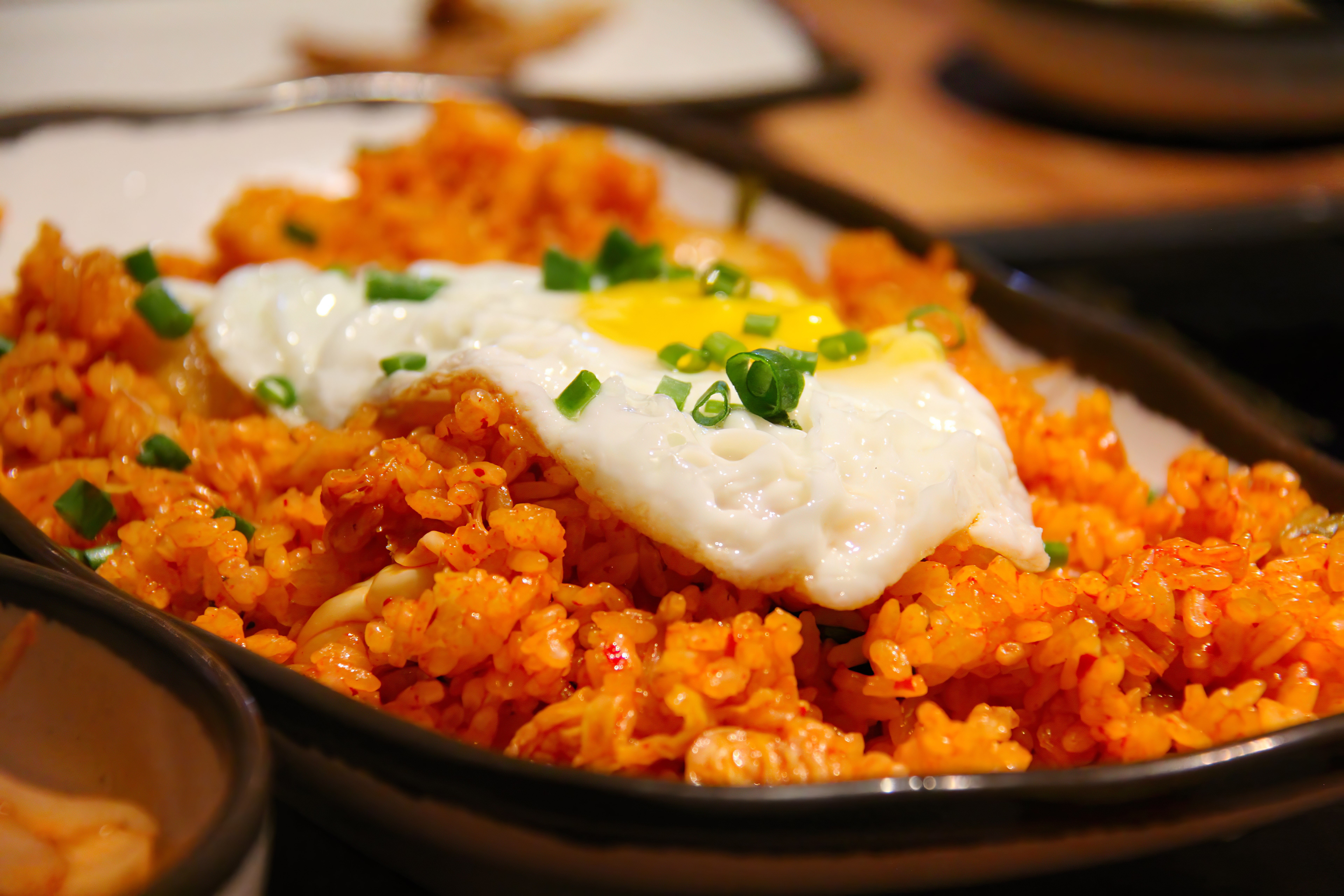
Kimchi fried rice doesn’t need any more streamlining – it’s already so easy. But this oven method spreads the rice out over a baking tray, increasing the potential for that coveted nurungji, or scorched rice. By baking this dish, you can start with fresh rice (no need for day-old), as the dry oven heat draws the moisture from the wet grains and turns them crispy-chewy. The only active cooking required here is stirring together the ingredients. The oven handles the rest, which means no actual stir-frying. Eggs cracked on top, gently baked to silky perfection, are a necessary finish, as the runny yolks sauce the gochujang-infused rice.
Total time: 45 minutes, plus rice cooking time
Serves: 4 to 6
Ingredients:
400g uncooked medium-grain white rice
60ml toasted sesame oil
60ml gochujang
60ml napa cabbage kimchi juice, plus 450g kimchi, coarsely chopped
3 tbsp soy sauce
2 tsp granulated sugar
Salt
1 large onion, cut into medium dice
3 tbsp unsalted butter, cut into small pieces
20g gim (often labeled as roasted seaweed), crushed
6 large eggs
Method:
1. Place the rice in a sieve and rinse it under cold running water, shaking constantly, just a few seconds. Add the rinsed rice and 480ml cold water to a rice cooker or medium pot and soak for 10 minutes. If using a rice cooker, turn it on and cook rice until soft and fluffy. If using a pot, bring the water to a simmer over high heat, then reduce the heat to very low, cover and continue simmering, without peeking, for 20 minutes; remove the pot from the heat and let the rice finish steaming, still covered, until the grains are soft, distended and a little shiny, about 10 minutes. Uncover your cooked rice, fluff with a fork and set aside.
2. Position a rack in the middle of the oven and heat to 220C.
3. In a large bowl, whisk together the sesame oil, gochujang, kimchi juice, soy sauce and sugar. Season generously with salt, then stir in the chopped kimchi and onion. Add the cooked rice, butter and seaweed and stir to combine. Taste and adjust seasoning with salt.
4. Transfer the rice mixture to a large rimmed baking tray and spread out loosely. Bake until the top of the rice is crispy and chewy but not burnt, 25 to 30 minutes, opening the oven door halfway through (to check on it, but also to let excess moisture out during the cooking).
5. Remove the pan from the oven. Using a spoon, create 6 shallow depressions in the rice. Crack the eggs into the depressions and place the pan back in the oven until the egg whites have just set, 3 to 6 minutes. Serve immediately, while the eggs are still runny.
Seolleongtang
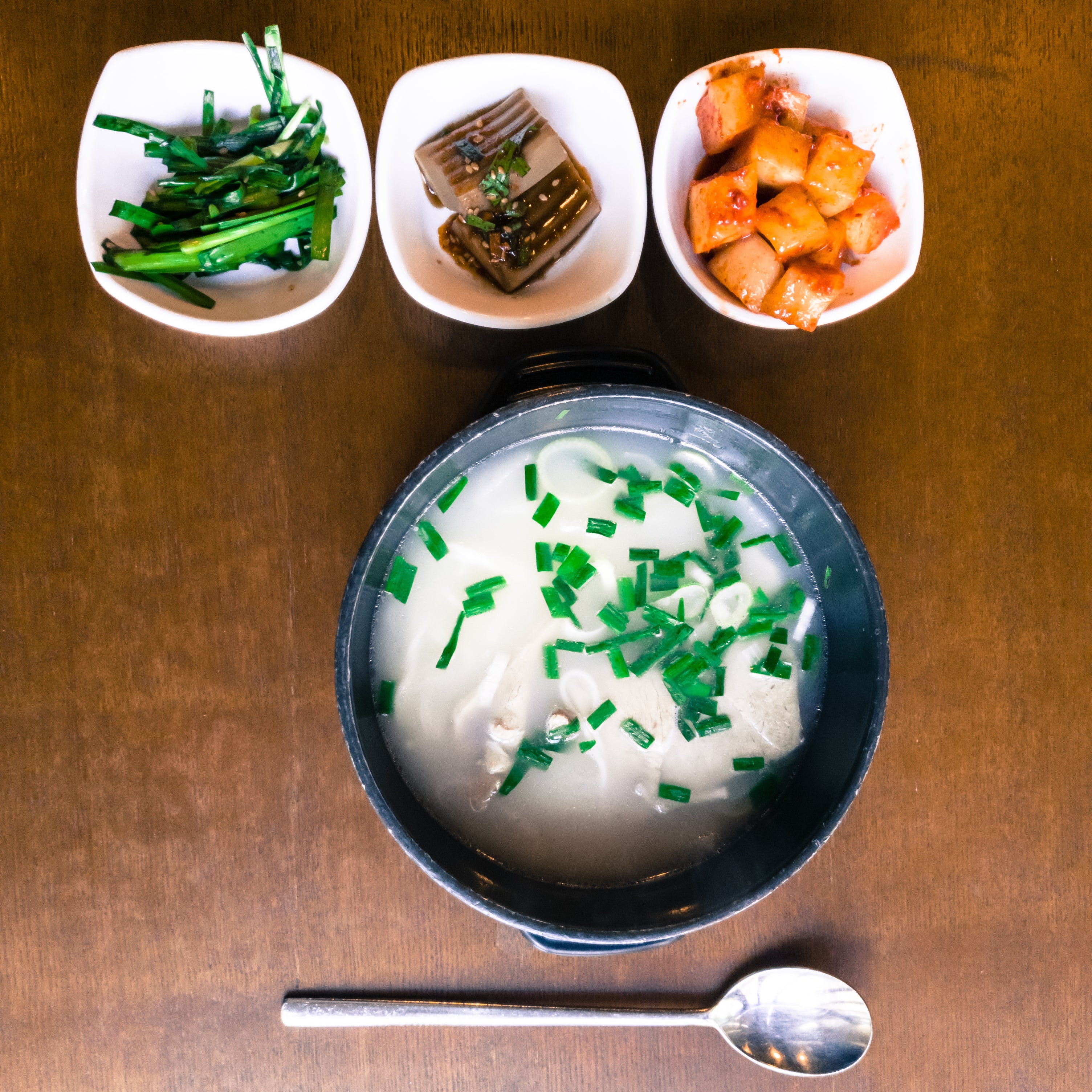
Seolleongtang (SULL-lung-tahng) is a deeply comforting dish seemingly magicked out of just beef bones, sometimes a small hunk of meat, and spring onions, if you have them. This version is especially pared down, relying mostly on the bones, which are boiled over multiple hours to imbue the broth with fatty redolence. The best seolleongtang is made from reused bones kept specifically for seolleongtang, which is why batches made with fresh bones may not have the quintessential milky whiteness characteristic to this dish. The broth is seasoned with a quick, gremolata-like mix of spring onion, garlic and sea salt.
Total time: 3½ hours
Serves: 4
Ingredients:
1.3 to 1.8 kg beef leg bones (see tip below)
450g brisket or chuck roast
8 spring onions, thinly sliced
8 garlic cloves, finely grated
4 tsp flaky sea salt, plus more as desired
Steamed white rice, for serving
Very ripe radish kimchi, for serving
Method:
1. Place the beef bones and brisket in a very large stockpot (the biggest you have), and add enough cold tap water to fully cover by 2½cm. Bring to a boil over high heat and cook until the bones and meat are no longer pink and a gray foam collects at the surface, about 10 minutes. Drain in a colander and rinse the bones under cold tap water. Rinse out the pot, as well, if it is especially dirty, and add back the bones and meat.
2. Add 4.7L cold tap water to the pot and bring to a boil over high heat, then reduce the heat to gently boil. Partly cover and cook until the soup is rich with marrow flavour and milky-white in color, about 3 hours (for the milkiest soup, you want to maintain this gentle boil, which should be more vigorous than a simmer but less volatile than a hard boil). During these 3 hours, you don’t need to stir, but you should check the water level once or twice to make sure the bones stay covered with liquid; add more cold tap water to the pot if this level gets too low, which can happen if your stove is especially strong.
3. Carefully drain the contents of the pot into a colander set in a large bowl. Take out the brisket, slice it thinly against the grain and set aside. Rinse, cool and freeze the bones to use them again another time. At this point, you can refrigerate the soup overnight to remove the fat, which will harden on top once chilled and be easy to remove (don’t forget to refrigerate the brisket, too), or you can pour it back into a clean pot and, just before serving, bring to a simmer over medium heat, skimming the fat off the top with a ladle. Season generously with salt.
4. While the soup is reheating for serving, prepare the spring onion garnish: in a small bowl, stir together the spring onions, garlic and flaky sea salt.
5. Divide the brisket among large bowls and ladle over the hot soup. Sprinkle some of the spring onion garnish over each bowl, leaving the rest on the table so everyone can add more as they eat. The soup should be well seasoned with salt and aromatic from the savoury spring onions and garlic. Serve with white rice and radish kimchi.
Tips: You can find bags of frozen beef bones for bone soups like this seolleongtang at Korean supermarkets, where they are often labelled, austerely, “beef bones” or “beef leg bones”. At other grocery stores and butcher shops, they might be labelled “beef marrow bones”. All that matters is that you use a marrow-rich beef bone for this recipe, as marrow is the main flavouring in seolleongtang.
Any fish jorim
Fish jorims, such as eundaegu (black cod) and godeungeo (mackerel), are staples of Korean home cooking. This easy variation highlights the aromatic flavour of soy sauce, garlic and ginger, a combination that seeps into bone-in, skin-on fish. Steaks of black cod, mackerel and salmon work best here, as they seem almost to melt into rich silkiness, but you could use whatever fatty fish and cut you like. The whole red radishes in this recipe, replacing the more typical Korean radish slabs, gently boil in the salty-sweet liquid until tender, lending their vegetal sweetness to the velvety broth. A barely steamed, basically raw relish of spring onions, red onion and jalapeño adds freshness and crunch.
Total time: 30 minutes
Serves: 4
Ingredients:
225g trimmed whole red radishes (from about 1 bunch)
60ml soy sauce
2 tbsp toasted sesame oil
2 large garlic cloves, crushed and minced
1 (2½cm) piece fresh ginger, peeled, crushed and minced
1 tbsp granulated sugar
1 tsp gochugaru
675g bone-in, skin-on pieces of fatty fish, such as black cod, mackerel or salmon steaks
2 spring onions, trimmed and thinly sliced on the diagonal
1 very small red onion, halved and thinly sliced
1 jalapeno, very thinly sliced into rings
Steamed white rice, for serving
Method:
1. In a large, wide pot or casserole dish, place the radishes, soy sauce, sesame oil, garlic, ginger, sugar and gochugaru. Add 350ml cold tap water and bring to a boil over high, stirring once or twice, then lower the heat to maintain a gentle boil. Cover the pot and cook until the radishes start to get tender but are still slightly firm in the center, 5 to 7 minutes.
2. Gently nestle the fish pieces into the pot, using a spoon to baste the tops with some of the braising liquid. Bring the mixture back to a boil, then reduce the heat to maintain a simmer and cook, uncovered, until the radishes are meltingly tender and the fish is just cooked through or no longer opaque in the center, 9 to 12 minutes.
3. Evenly top the fish with the spring onions, red onion and jalapeno. Turn off the heat, cover and let the vegetables steam until slightly less raw but still fresh and crunchy, 1 to 2 minutes. Serve the pot in the center of the table, family-style, with a ladle and bowls of fresh white rice.
Cheesy cabbage tteokbokki
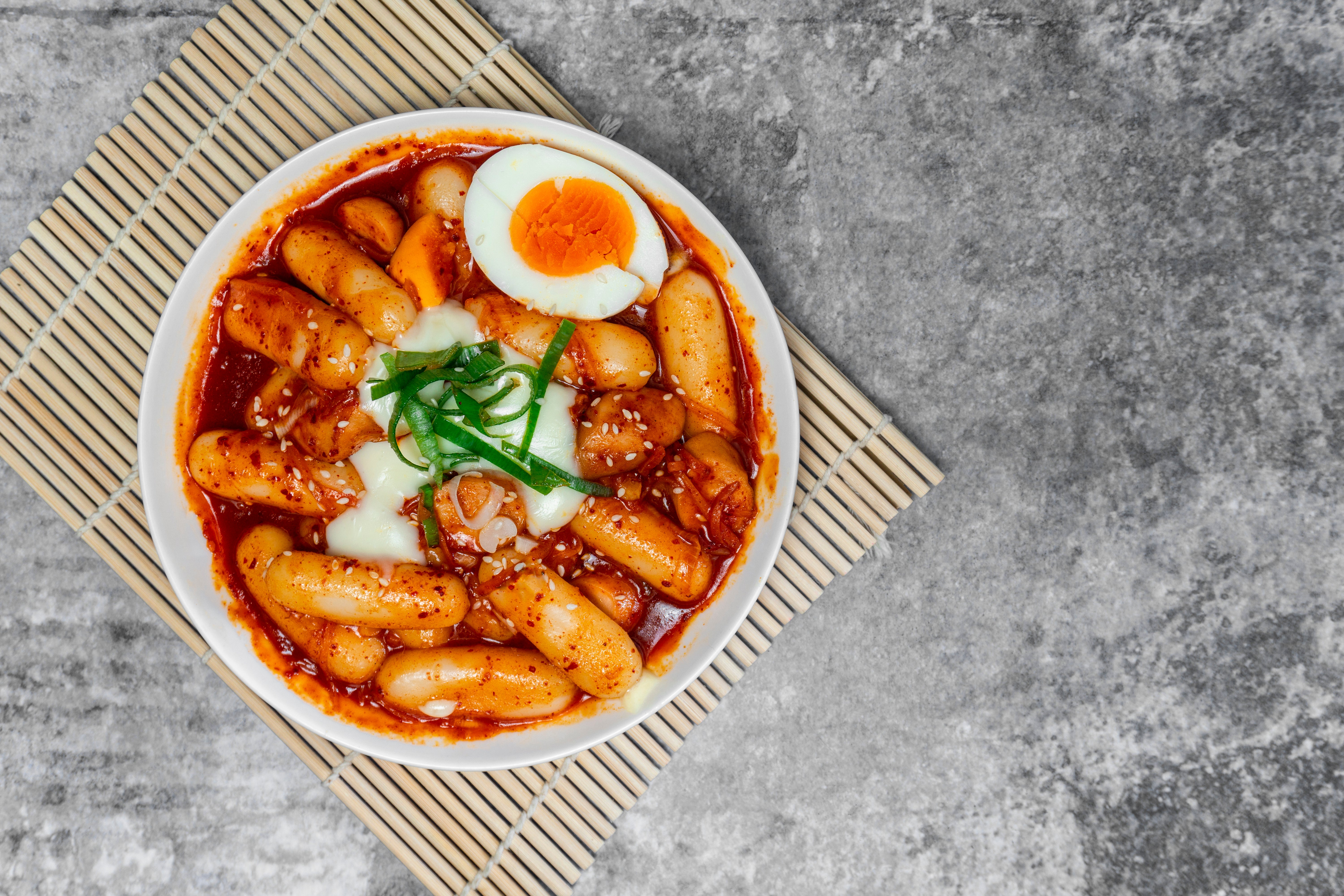
A dish of royalty, tteokbokki consists of chewy Korean rice cakes (tteok) that are stir-fried (bokki) and slicked in a savoury-sweet sauce. Sometimes the sauce is soy-sauce-based, as the kings of the Joseon dynasty enjoyed in the royal court dish gungjung tteokbokki. But more commonly today, as it is here, the sauce is gloriously red, spicy and gochujang-based. Traditional versions might include fish cakes and whole hard-boiled eggs, but this one leans into a base of butter-fried shallots and a layer of melted cheese covered in a crunchy blanket of raw cabbage. A parade of halved, molten-centred soft-boiled eggs bedecks the top.
Total time: 30 minutes
Serves: 4
Ingredients:
3 large eggs
1 tbsp granulated sugar
3 tbsp gochujang
1 tbsp soy sauce
1 large garlic clove, finely grated
3 tbsp unsalted butter
2 large shallots, thinly sliced crosswise into rings
Salt
450g fresh or frozen tteok (rice cakes)
60g shredded cheese, such as sharp cheddar or low-moisture mozzarella
140g green cabbage, shredded (about 2 cups)
Method:
1. Bring a small pot of water to a boil over high heat. Add the eggs carefully and reduce the heat to gently simmer the eggs until soft-boiled, 6 to 7 minutes. Drain the eggs, leaving them in their pot, then shake the pot to crack their shells. Cover the cracked eggs with cold water to shock them, then let cool enough to touch. Once they are sufficiently cooled, peel the eggs directly in the water (they should peel easily); set aside.
2. In a small bowl, stir together the sugar, gochujang, soy sauce and garlic. Set aside.
3. In a large pan, melt the butter over medium-high heat. Add the shallots, season generously with salt and cook, stirring constantly, until the edges of the shallots are really brown, 5 to 7 minutes. Stir in the gochujang mixture and cook, stirring for a few seconds, just until the sauce loses its raw edge.
4. Stir in 240ml cold tap water and add the tteok, making sure to separate them if stuck together. Bring to a simmer over medium-high and cook until the sauce thickens and the tteok are heated through but still chewy, 4 to 6 minutes (add a minute or two if using frozen rice cakes).
5. To serve, scatter over the cheese, followed by the cabbage – a nice, crunchy blanket of it. Cover to let the cheese melt; the cabbage will steam slightly and lose some of its raw edge. Halve the soft-boiled eggs and arrange them over the crunchy, cheesy cabbage.
Tongdak gui (whole roasted chicken)
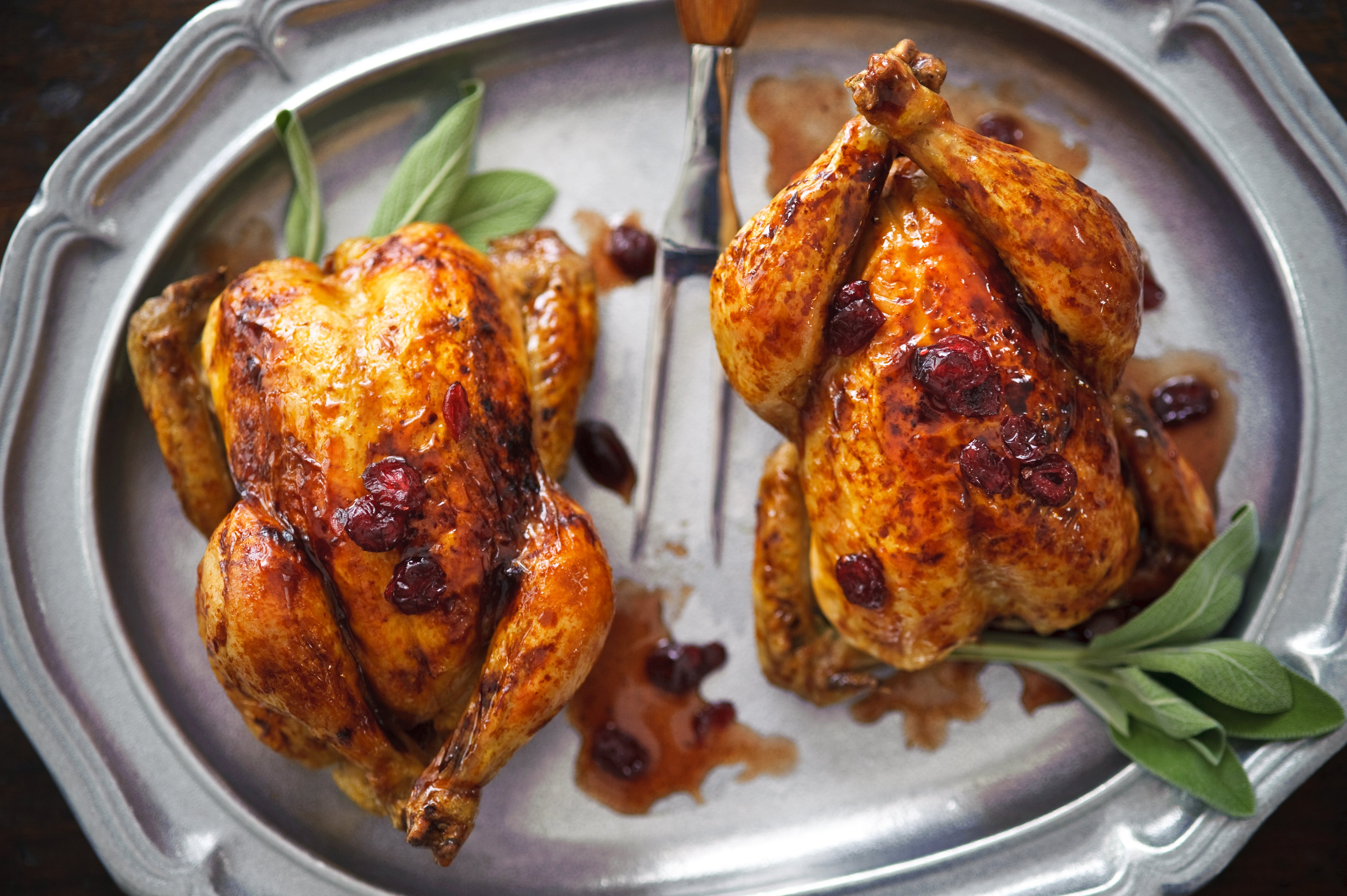
This recipe draws inspiration from the old-fashioned rotisserie chickens sold along Seoul’s streets in the 1970s – before Korean fried chicken entered the scene in the next decade. Cornish game hens are an excellent substitute for the smaller, younger birds often used in South Korea for this succulent poultry dish. A simple soy-sauce brine, made even more fragrant with ground white pepper, ensures inimitably juicy, tender meat that, after roasting in the oven for an hour, truly falls off the bone. A nod to pa dak (“spring onion chicken”), an early-2000s trend in which shaved spring onions were served atop fried chicken to cut the fattiness, this recipe calls for lightly dressed spring onions for a verdant counterpoint.
This recipe is pared down to its essentials, though you could supplement the funky, savoury-sweet flavours here with traditional additions like a sprinkle of raw pine nuts, a palmful of Korean radish cut in matchsticks or a spoonful of saeujeot, salted fermented shrimp.
Total time: 1¼ hours, plus at least 8 hours’ brining
Serves: 4
Ingredients:
60ml soy sauce
30g coarse salt or ½ cup salt, plus more for the spring onions
30g granulated sugar, plus more for the spring onions
1 tsp ground white pepper
2 Cornish game hens (about 1.5 kg total)
2 tbsp olive oil
4 spring onions, cut into 10cm segments, then very thinly sliced lengthwise
1 tbsp rice vinegar
Steamed white rice, for serving
Yangnyeom sauce, for dipping (optional)
Method:
1. Place a 4½L resealable plastic bag in a large bowl. To the bag, add the soy sauce, salt, sugar, white pepper and 1.4L cold tap water; stir to dissolve the salt and sugar. Nestle the Cornish game hens into the liquid, seal the bag set in the bowl and place in the refrigerator to brine for at least 8 hours and up to 48 hours.
2. When ready to cook, heat the oven to 180C. Drain the hens in the sink and pat very dry with a clean towel (the drier the hen, the crispier the skin). Using your hands, massage the olive oil all over the birds and place on a baking tray, breast side up. Roast, rotating the pan halfway through, until golden brown and the legs, when jostled, feel like they’re about to fall off (a sign that the meat is tender and cooked through), about 1 hour.
3. Meanwhile, in a small bowl, toss the spring onions with the rice vinegar and a pinch of salt and sugar to taste. To serve, top each roasted hen with a mound of the spring onion garnish and enjoy with steamed white rice and yangnyeom sauce (if using), for dipping.
And to drink
With the more assertive flavours of Korean food, I like young, equally bold wines rather than nuanced, subtle or aged wines that might get washed over by the spice and umami flavours. Among whites, I would look at sauvignon blancs, rieslings (either dry or moderately sweet), crisp Italian options, grüner veltliners and other similar bottles. I love fino sherries with spicy foods, but sherry is not to everybody’s taste. I would also choose fruity reds, like grenaches, whether from France, Spain or the United States, cabernet francs, zinfandels and myriad vins de soifs – thirst-quenching wines. My one caveat would be to avoid wines high in alcohol, above 14.5 per cent. Other good choices include frappato or Cerasuolo di Vittoria from Sicily, Beaujolais and Rioja crianzas.
© The New York Times
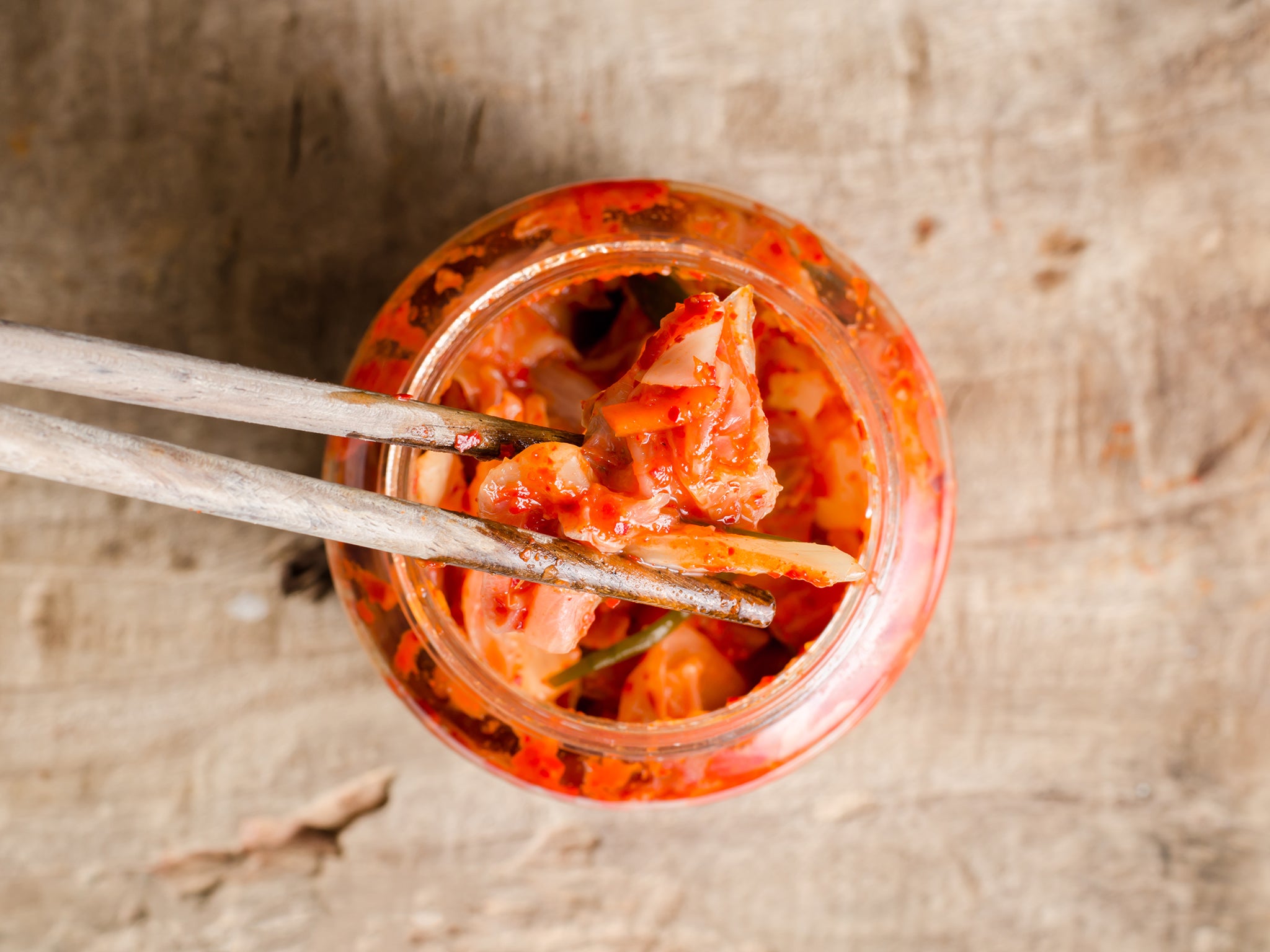



Join our commenting forum
Join thought-provoking conversations, follow other Independent readers and see their replies
Comments